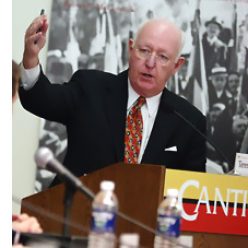The Chesapeake Bay had a good week last week.
The annual report card on the Bay’s overall health from the University of Maryland’s Center for Environmental Science (UMCES) showed significant improvement, one-design sailboats from around the nation had a rollicking regatta in the waters off Annapolis, and just days before that, Congress preserved funds for the Chesapeake Bay Program for the balance of the fiscal year.
Nothing in Washington is permanent, of course, so the budget battle will resume in September for FY2018 and the Trump Administration is still threatening to zero-out the $73 million annual appropriation for the Chesapeake Bay Program, which is headquartered in Annapolis.
The White House has other environmental programs in its budget crosshairs as well. It is calling for substantial reductions in funding for the E.P.A, NOAA and the intricate network of federal agencies that together allocate more than $500 million a year to the restoration of the Chesapeake Bay’s waters and fisheries. Congressional members from Maryland and Virginia will do what they can to preserve the federal funds, but some sort of a fiscal haircut seems likely come September.
The painful irony is that this assault on the nation’s environmental programs comes just as the Bay and its tributaries seem to be turning the corner. The UMCES report found that, after decades of work, the largest estuary in the nation is making a steady, measurable recovery.
The Bay earned an overall grade of C on the 2016 UMCES report card: not dean’s list, perhaps, but one of the highest scores recorded in years. (Unfortunately, Anne Arundel County’s sluggish rivers lagged behind with a D+.) The Fisheries Index, made up of blue crab, striped bass and bay anchovies, rebounded to an A, a dramatic sign that the restoration effort is working.
The Trump Administration took no notice, however, and promised to redouble its budget-cutting efforts. The Trump formula: billions more for rebuilding the military and national security, sharp reductions in “discretionary” spending, including the environment.
“I do not think Donald Trump connects with the environment if he cannot play golf on it, or own it,’ said Dr. Thomas Miller, the director of the Chesapeake Biological Laboratory, an arm of UMCES in Solomons Island. “I sense a profound lack of interest in environmental issues as president and personally throughout his career as a developer.”
Miller worries that if the Chesapeake Bay Program is eliminated or even substantially trimmed, it will no longer be able to monitor the progress being made by the six states and District of Columbia that make up the 64,000-square-mile Chesapeake Bay watershed. Under the terms of the 2014 Chesapeake Watershed Agreement, the states committed themselves to make major progress towards cleaning up the Bay by 2025. It is the Chesapeake Bay Program that coordinates and monitors their efforts to insure that they live up to their commitments.
Tom Horton, the Eastern Shore journalist and author that many regard as the bard of the Bay, is concerned that if the federal funds supporting this effort are cut, the individual states will not make up the difference. “You can’t assume that the states will pick up the slack,” he said, “Pennsylvania is already struggling to find the money to do what it is committed to do.”
Horton doubts that the Trump Administration, despite its threats, will succeed in eliminating the Chesapeake Bay Program in 2018, but, he said, “even a modest cut sends a signal that says: ‘don’t bother about the Bay.’”
One statistic might give the Trump budget-cutters pause: a healthy Chesapeake Bay is an economic engine that generates over 5,000 seafood industry jobs and an annual income of $56 million. Altogether, the watershed’s regional economy provides 8.3 million jobs and an annual income of almost $400 billion.
Real money, as they say, even in today’s Washington.
